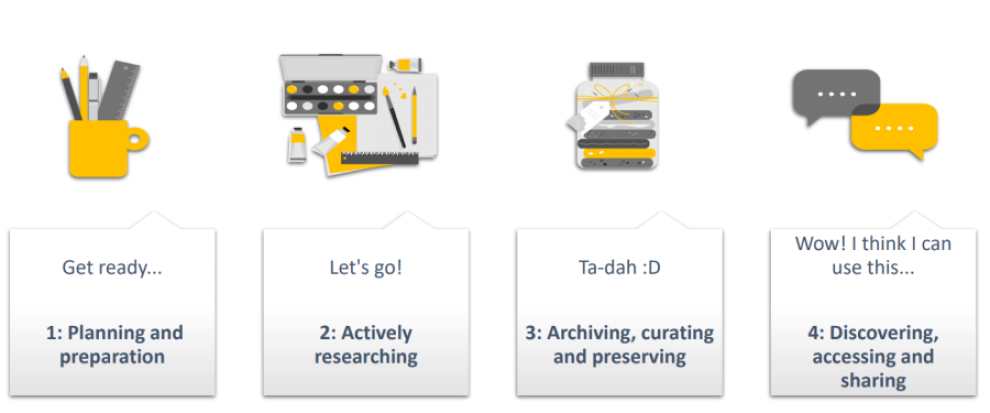Learn more about using the research data lifecycle to inform your data management planning
Contents
- What are research data at UCL?
- What is the research data lifecycle?
- What is a Data Management Plan?
- Why are Data Management Plans useful?
- Before you get started
- DMP Training and Review Service
- UCL Research Data Policy
- DMPOnline
What are research data at UCL?
According to the UCL Research Data policy, data are: “facts, observations or experiences on which an argument or theory is constructed or tested. Data may be numerical, descriptive, aural or visual. Data may be raw, abstracted or analysed, experimental or observational. Data include but are not limited to: laboratory notebooks; field notebooks; questionnaires; texts; audio files; video files; models; photographs; test responses”.
There are three kinds of data:
- Open - data which are freely available online;
- Controlled/restricted - data access is restricted on the basis of there being ethical, legal and/or commercial reasons prohitbiting their open release. Potential secondary users must meet certain criteria before access is given;
- Closed - data which are permanently embargoed due to their nature.
What is the research data lifecycle?
The research data lifecycle models the different phases of the research process - from planning and preparation through to archiving and sharing - making your research and outputs discoverable to the wider research community and members of the public. There are four phases:
- Planning and preparation - You've had an idea for a research study so it's time to start making plans and getting prepared. It's usually during this phase you will write a data management plan and perhaps submit it as part of a grant application.
- Active research - You are now actively researching putting all those research plans into action.
- Archiving, curating and preserving - The research is complete and it's time to archive your research outputs to preserve them for the longer-term.
- Discovery, access and sharing - making your research discoverable to others for potential reuse can help to maximise research opportunities.

Four phases of the research data lifecycle - Planning and preparation; Active research; Archiving, curating and preserving; Discovery, access and sharing.
- Download high resolution Research Data Lifecycle (PDF)
What is a Data Management Plan?
A Data Management Plan (DMP) describes your planned and/or actioned data management and sharing activities. It is generally 1-3 pages in length and should cover the four phases of the research data lifecycle. It is generally written at the start of a research project and should be revisted at different stages of the project and updated where necessary. DMPs may be published in the UCL Research Data Repository and assigned a DOI.
When writing your plan, remember to check if any funder's policies and requirements apply to your rseearch. A range of how-to guides are also available to assist you in writing your plan.
Why are Data Management Plans useful?
In addition to often being a prerequisite to receiving certain grants, DMPs are useful for:
- maximising the research potential of existing research outputs by reusing and repurposing them
- thinking about and developing your strategy for issues such as data storage and long-term preservation, handling of sensitive data, data retention and sharing, early on in your research.
- anticipating legal, ethical and commercial exceptions to releasing data; deciding who can have access to data in the short and long term.
- estimating the costs of your research project, which can then be included in your project budget.
Before you get started
Here are a few tips to help you start writing a DMP:
- Verify which data management and data sharing policies apply - these could be institutional, funder or journal publisher-led.
- Identify whether you will need to enter into a data sharing agreement before datasets and other study materials may be shared. There could also be legal frameworks and copyright issues to be mindful of. There is more information about material transfer agreements.
- Where research involves living human participants, it is recommended you speak with the Data Protection team to confirm which data protection legislation apply. Where you are collaborating with partners based globally, confirm whether international data protection legislation apply to your research.
- Verify submission deadlines.
DMP Training and Review Service
The RDM team offers both face-to-face and online training courses on how to write a data management plan. Using the UCL DMP template, attendees have the opportnity to write a data management plan which they can take away with them and use as a basis for a more detailed plan of their data management and sharing activities.
For more help and advice, contact your Research Data Support Officers who can also review drafted UCL Data Management Plans if you send them in advance of submission (allow 1 to 2 weeks at least before your submission deadline).
UCL Research Data Policy
The UCL Research Data Policy describes UCL's expectations relating to data management and sharing within the wider Open Science context.
DMPOnline
DMPonline, a free tool created by the DCC, provides a framework for creating your Data Management Plan. UCL guidance is now incorporated into DMPonline; see our further guidance on using the tool.
 Close
Close

